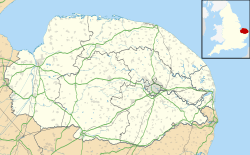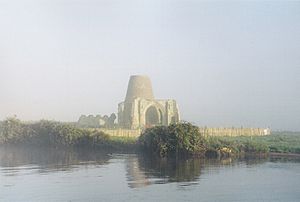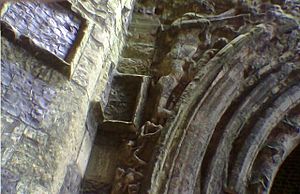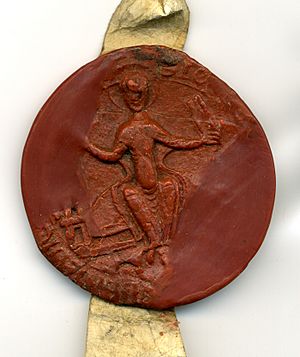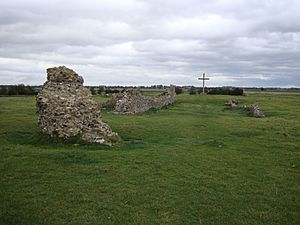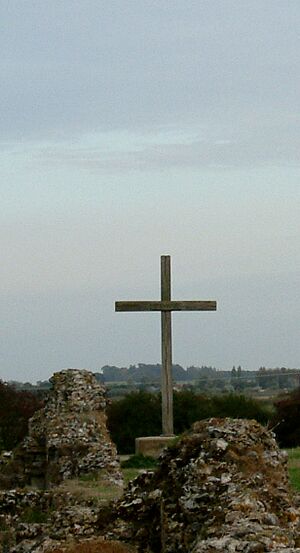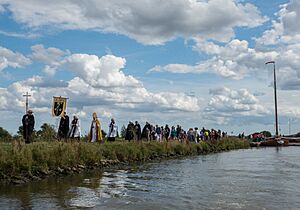St Benet's Abbey facts for kids

St Benet's Abbey and wharf from the River Bure
|
|
| Monastery information | |
|---|---|
| Other names | St Benet's Abbey, Holme |
| Order | Order of St Benedict |
| Established | 9th century |
| Diocese | Norwich |
| People | |
| Important associated figures | Saint Suneman; Saint Wulfric; Abbot Elsinus; Abbot Aelfwold; King Canute; John of Oxnead; Conrad, prior of Christ Church Cathedral Priory, Canterbury; Hugh, abbot of Lagny; Sir John Fastolf; Bishop William Rugg |
| Site | |
| Location | Norfolk, England |
| Coordinates | 52°41′11″N 1°31′29″E / 52.6864°N 1.5247°E |
| Visible remains | gatehouse, lower walls of sanctuary and earthworks |
| Public access | yes |
| Other information | Property of Norfolk Archaeological Trust, Diocese of Norwich |
St Benet's Abbey was an old monastery in Norfolk, England. It was home to monks from the Order of Saint Benedict. The abbey was also known as St Benet's at Holme or Hulme. It was built next to the River Bure in an area called the Broads. St Benet is an old English way of saying St Benedict of Nursia, who is known for starting monasticism (the way monks live) in the West.
During the time of the Dissolution of the Monasteries, the King took control of the abbey's lands and buildings. These were then given to the church leaders in Norwich. Even though the monastery was supposed to stay open, the monks soon left. Today, only ruins of the abbey remain.
Contents
St Benet's Abbey: An Ancient History
It's a bit tricky to know the exact early history of the abbey. This is because old records don't always agree with what we know about the area's past.
People say that St Benet's was built where an even older monastery stood in the 9th century. At that time, a holy man named Suneman was killed there by Vikings. Around the late 900s, a man named Wulfric rebuilt the monastery. Later, around 1022, King Canute gave the abbey some land and villages. These were Horning, Ludham, and Neatishead.
King Canute also gave money to another Benedictine monastery. This was at Beodricsworth, which later became Bury St Edmunds Abbey. This place was important because it held the remains of St Edmund, a martyred king. Half of the monks from St Benet's Abbey, led by Prior Uvius, moved to Bury. They took half of their furniture, books, and other church items with them. Uvius became the first abbot of Bury and led it until 1043. His replacement, Leofstan, was also a former monk from St Benet's.
Other people who helped St Benet's Abbey early on included Earl Ralf II of East Anglia and Edith Swannesha. She was the partner of King Harold II.
In 1065, St Benet's Abbey was strong enough to start a smaller monastery, called a "cell," in Suffolk. This later became Rumburgh Priory. However, by the late 1100s, it became part of St Mary's Abbey in York.
The first abbot of St Benet's, Elsinus, brought in stone to rebuild the abbey's church. This was a big job because there isn't much stone nearby. The second abbot, Thurstan, finished the work. He was buried in the church when he died in 1064.
During the Norman conquest, King Harold Godwinson put the abbot of St Benet's in charge of defending the East Anglian coast. This was part of his duty as a powerful landowner. The abbey had to help provide a fighting ship for the King. It's even possible that the abbey gave King Harold his own ship.
Life at the Abbey After the Norman Conquest
After the Norman conquest, William the Conqueror punished those who had supported King Harold. Abbot Aelfwold was forced to leave England and go to Denmark for a while. The abbey's lands also suffered. Nearby landowners and followers of Sir Roger Bigod, a powerful Norman lord, caused problems for the abbey. This harassment continued for a long time.
For example, during the reign of King Henry II (1154-1189), the church at Ranworth, which belonged to the abbey, was stolen! It was a wooden building, so it was taken apart and moved. The King had to order it to be returned.
John of Oxnead, a monk from St Benet's in the 1200s, wrote in his Chronicle that Abbot Aelfwold was able to return. He died at the abbey in 1089. Ralph became abbot next, followed by Richard in 1101. Richard is known for finishing the church's western tower and hanging two large bells there.
The abbey also faced natural disasters. In the 1200s and 1300s, strong storms caused the sea to break through the sand dunes. This damaged the abbey. In 1287, they even had to bring horses into the church's main hall to keep them safe from the floods!
The abbey also needed protection from attacks by water. In 1327, the King gave permission for the site to be surrounded by a wall with battlements (parts for defense). You can still see small traces of this wall today.
Records from the 1100s show that some of the abbey's tenants paid their rent in goods or services. For example, a mill and land at Swanton Abbott were rented for four fat chickens a year. Land at Potter Heigham was paid for with beer for the monks. Another piece of land was rented for honey, and a property in London for pepper and cumin. Two churches had to give the abbey a pound of incense each year.
Important Abbots and Their Connections
The abbey continued to have links to the royal court. In 1126, Conrad became abbot. He had been a prior (a leader) at Christ Church Cathedral Priory in Canterbury. He was also a confessor (someone who hears confessions) to King Henry I. Conrad brought special items to St Benet's, including two robes and a book that had belonged to St Dunstan, a famous Archbishop of Canterbury. He also brought a chalice (a cup for religious ceremonies) that Dunstan himself had made. These items were kept at St Benet's as relics.
Later in the same century, another abbot with even stronger connections came to lead St Benet's. This was Hugh, who was related to many powerful people. He was the half-brother of a Cardinal and a Count. His half-sister was the Queen of France, and he was the nephew of King Stephen of England.
Hugh was a knight who was wounded in battle around 1136. After recovering at a monastery in France, he decided to become a monk. He became abbot of St Benet's from 1146 to 1150, thanks to his uncle, King Stephen. The previous abbot, Daniel, was removed to make way for Hugh.
John of Oxnead's Chronicle says Hugh was a good abbot but made powerful enemies. King Stephen later helped Hugh become abbot of Chertsey Abbey. Abbot Daniel then returned to St Benet's. When King Stephen died, it became difficult for Hugh's family in England. Hugh left England and returned to France. He later became abbot of Lagny Abbey but was removed in 1171 and died soon after.
Local Beliefs and Saints
Even though the abbey had some success, it might have struggled to be as famous as other religious places. This was because it didn't have the remains of a very important saint. It seems the abbey tried to promote the story of St Margaret of Holm. She was supposedly a girl killed in the woods in 1170. However, this story didn't become very popular.
Generous Gifts to the Abbey
The abbey's life began with generous gifts, and these continued over time. By the late 1200s, St Benet's owned property in 76 different parishes (local church areas).
One of the abbey's biggest supporters was Sir John Fastolf. He is said to be the inspiration for Shakespeare's character Falstaff. Sir John died at Caister and was buried at St Benet's in December 1459. He was buried next to his wife, Millicent, in a new part of the church he had built himself.
What Happened to the Abbey?
After the Dissolution of the Monasteries, most of the abbey buildings were torn down. Only the gatehouse remained. This gatehouse is now a very important historic building.
In the late 1700s, a farmer built a windmill inside the abbey gatehouse. This windmill was later changed into a windpump to drain water from the land. To make room for the windmill's sails, the second floor of the gatehouse was removed.
People started paying more attention to draining the marshland around the abbey in the early 1700s. A first windmill for drainage was built around the mid-1700s. Later, another one was attached to the front of the ruined gatehouse. By 1813, the upper floor of the gatehouse was removed so the windmill sails could turn. The sails were still there in 1854 but were gone by 1863.
The old wind-powered pump is now also a ruin, but it is still a protected historic building.
Between 1782 and 1886, there was a pub called The Chequers right by the river, near the gatehouse.
In 1925, the site became one of Britain's first scheduled ancient monuments. This means it is a nationally important archaeological site.
In 1993, the main part of the site was bought by the Crown Estate. In 2002, it was sold to the Norfolk Archaeological Trust. This trust also bought the gatehouse and mill in 2004. The ruins of the church still belong to the Diocese of Norwich, but they have leased them to the Trust for 199 years.
In recent years, important repairs have been done to the ruins. It's now easier to visit the site, with a new car park and paths. Many volunteers have helped by recording graffiti, studying wildlife, and guiding visitors. The site has become very important to local people.
On August 2, 1987, a cross made from oak wood was put up at the high altar. The wood came from the royal estate at Sandringham.
Who Were the Abbots?
Here is a list of the abbots of St Benet's Abbey, with the years they were chosen:
| Year | Names |
|---|---|
| Wulfric | |
| 1020s | Aelfsige |
| 1046 | Thurstan de Ludham |
| 1064 | Aelfwold |
| 1089 | Ralph |
| 1101 | Richard |
| 1126 | Conrad |
| 1128 | William Basset |
| 1133 | Anselm |
| 1140 | Daniel |
| c. 1150 | Hugh |
| 1151 | Daniel (reinstated) |
| 1153 | William |
| 1168 | Thomas |
| 1186 | Ralph |
| 1210 | John |
| 1214 | Reginald |
| 1229 | Sampson |
| 1237 | Robert de Thorkeseye |
| 1251 | William de Ringfeld |
| 1256 | Adam de Neatishead |
| 1268 | Richard de Bukenham |
| 1275 | Nicholas de Walsham |
| 1302 | Henry de Broke |
| 1326 | John de Aylsham |
| 1347 | Robert de Aylsham |
| 1349 | William de Hadesco |
| 1365 | William de Methelwold |
| 1395 | Robert de Sancta Fide |
| 1395 | Simon de Brigham |
| 1411 | Richard de South Walsham |
| 1439 | John Marte |
| 1439 | John Kelyng |
| 1470 | Thomas Pakefield |
| 1492 | Robert Cubitt |
| 1505 | William Forest |
| 1510 | John Redinge |
| 1517 | John Salcot, alias Capon |
| 1530 | William Repps or Rugg |
Is the Bishop of Norwich Still an Abbot?
Some people say that St Benet's is the only religious house that King Henry VIII did not close during the Dissolution of the Monasteries. They claim he instead combined the role of Abbot with the job of the Bishop of Norwich. This would mean that the Bishops of Norwich have been abbots of St Benet's ever since.
Today, the Bishop of Norwich, acting as Abbot, comes to St Benet's once a year. He arrives by wherry (a type of boat) and gives a speech at a special service on the first Sunday of August.
However, when the King gave the abbacy to the Bishop, it was on the condition that he would keep a community of twelve monks. By 1540, there were no monks left. So, it seems the abbey actually stopped existing around that time. This means the claim that the Bishop is still the abbot might not be true. But it has become a popular local story!


